Rangoli is a common type of floor decoration art. Indian women employ beautiful Rangoli art to adorn their home’s entrance. We refer to our guests as a form of god or Atithi Devo Bhavah. At the entrance gate, rangoli is fashioned to preserve our guests’ hospitality. Creating Floral Symphony Rangoli art is fairly common in India, be it for a festival, occasion, or marriage ceremony. There are many different rangoli-making activities done at offices, colleges, families, and schools. This article will discuss the history, methods, and aesthetic appeal of rangoli creation, as well as how it enhances celebrations with happiness and positivism.
How do you define Rangoli?
“Rangavalli,” which means a row of colors in Sanskrit, is the source of the word “rangoli.” It is a type of décor and fortunate symbolism that involves drawing vibrant drawings on the floor, usually in front of residences, temples, and other revered locations. In India, the rangoli arts are called by several names, such as Mandana, Alpana, Saaz, Muggu, Kolam, Zuti, and many more.
The Rangoli’s Past
Historical narratives and Indian scriptures both make mention of the ancient beginnings of rangoli. Generations of Indians have created and preserved rangolis, an ancient traditional art form. A beloved custom since ancient times, handcrafted rangoli are now manufactured quickly, yet they are still very attractive.
Floral Symphony Rangoli Arts’ Significance
Rangoli is very important in terms of culture and spirituality.
It is thought to infuse the environment with good vibes, luck, and prosperity. Rangoli is a big part of greeting visitors at the front door. Every home office and workplace makes rangolis for the Diwali celebration. Filling different colors to create a stunning rangoli. With the right tools, creating rangolis may be a simple and elegant design.
Rangoli Examine Making Creative
One type of floor decoration is rangoli art. Tradition, culture, and innovation are all celebrated. Hands that make patterns with expertise weave tales of happiness, harmony, and the enduring beauty of India’s artistic legacy.

- Rangoli Design Exhibition India’s Vast Variety of Cultures
Through inventiveness, color, and pattern, rangolis highlights the rich diversity of Indian culture. Various rangoli designs and arts throughout festivals and celebrations exhibit India’s cultural variety. Styles and variants of rangoli vary among Indian locales. The art of creating rangoli sometimes referred to as “kolam,” is highly common in South Indian culture. During Kerala’s biggest celebration, Onam, people create floral Rangoli designs for King Mahabali daily for ten days to honor him.
During religious rites and rituals, people make rangoli as an offering to the gods. It is believed to guard the house from bad energy and attract heavenly favors.
- Community Social Bonds
A type of cultural expression that unites communities is rangoli painting. Making rangoli is frequently a group activity in which friends, family, and neighbors collaborate to plan and embellish the area. It makes people feel more unified and fortifies social ties within the community.
Designs & Patterns for Floral Symphony Rangoli
Rangoli’s transient nature stems from being made on the ground, often washed away or destroyed after a few days. This impermanence symbolizes the fleeting essence of life. Depending on the event and the person’s skill level, rangoli designs can be simple and geometric or complicated and ornate. They frequently include geometric motifs, flowers, peacocks, religious symbols, and symmetrical and repeating patterns.
The complex designs and well-balanced colors of rangoli have inspired many artistic mediums, such as ceramics, textiles, and even architecture. Red, yellow, orange, green, and blue are frequent color choices; however, selecting the right color is crucial.
Materials for Floral Symphony Rangoli
There are no rules when it comes to creating Rangoli art; you may use any kind of material. Rangoli’s foundational product, colored powder, derives from natural components, enabling eye-catching color combinations. Sand and rice flour, the foundational ingredients, create the canvas for drawing rangoli designs. Traditionally, people use colored rice flour, crushed limestone, or flower petals to make rangoli. To make these patterns, people now also use colored chalk, rangoli stencils, colored sand, and even flower petals.
Handcrafted rangoli patterns hold a unique meaning. Stencils are extremely common these days and make creating lovely rangoli art quickly and easily. Making stencils has made creating lovely rangoli in under a minute simple.
Based on the Theme Arts of Rangoli
Rangoli artists can use themes in their artwork and designs. The style may change depending on the situation. The Rangoli art at the welcome door can convey a lovely message. Making rangoli art allows you to convey a certain message. You have the ability to write elegant prose with clear messages.
Hindu goddess-themed rangoli designs are highly common at the door. Welcome to the world of rangoli designs—designs for wealth. Rangoli designs for weddings, college and high school athletic events, Diwali, and other important occasions.
Steps to Make Floral Symphony Rangoli

- Choose Your Style
To begin, pick a rangoli pattern that appeals to you by going to the Shades of Spring Instagram page or any other source of inspiration. Pay attention to the design’s color scheme and pattern.

- Set Up Your Workspace
To make your rangoli, find a clear, flat area on the floor or any other suitable surface. Ensure that the space is dry and clean.

- Put a mark on the design
Mark the design on the designated area with chalk. Start by sketching your rangoli’s main design or motif. This might be any other design you’ve decided upon, such as a geometric pattern or a circle. To achieve a balanced appearance, make sure the design is symmetrical.

- Incorporate Detail and Color
Now, fill in the design with smaller, more vibrant flowers, like roses or other types. Make complex shapes and patterns for the rangoli design. Use a variety of colors to reflect your inspiration.

Conclusion
India has a lively and rich cultural legacy of rangoli. People commonly create this exquisite artwork for festivals, gatherings, and marriage rituals in India, enhancing the splendour of the festivities. It has profound metaphorical and spiritual meaning as well. It continues to play a significant role in Indian life and festivals and is a monument to the artistic inventiveness and cultural variety of the nation.





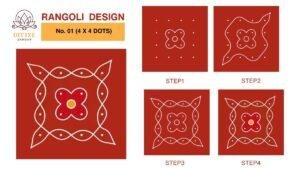

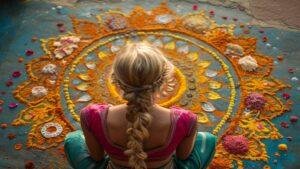





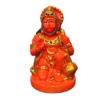
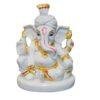



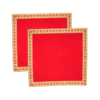
Add comment